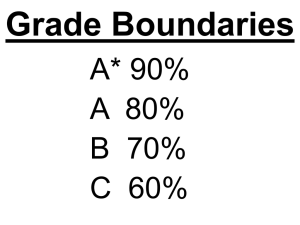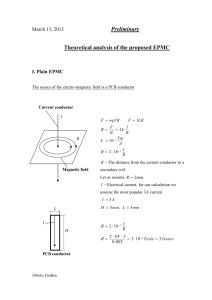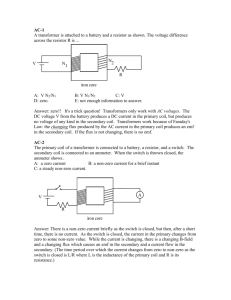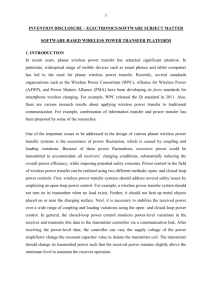Physics Research Experience for Six form Student
advertisement
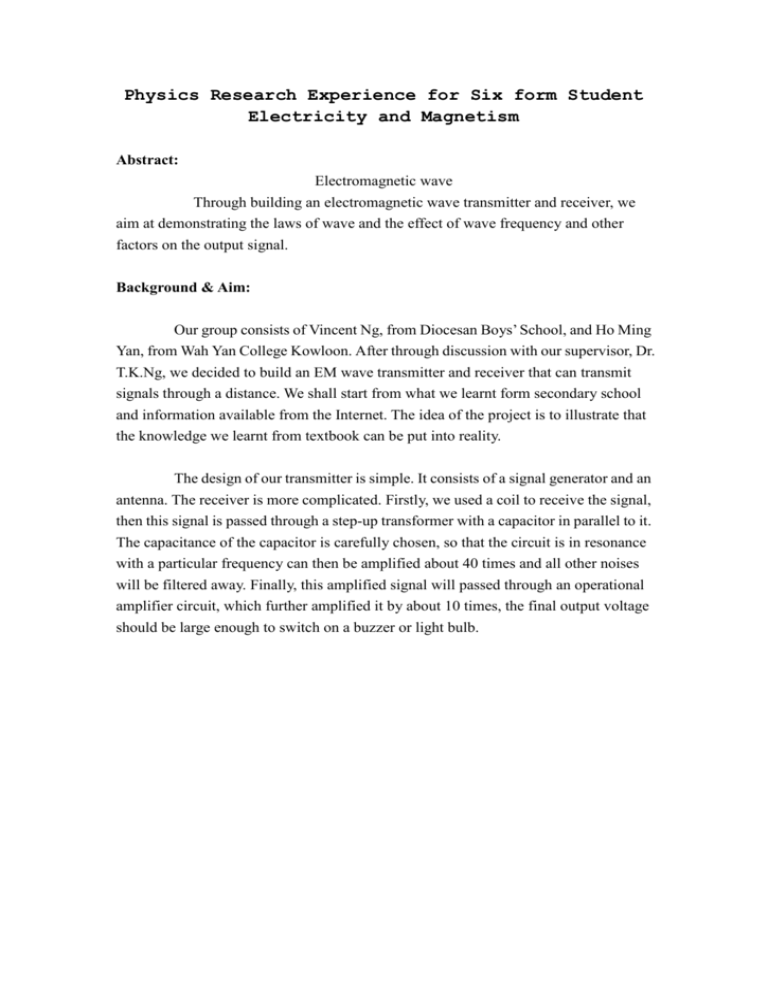
Physics Research Experience for Six form Student Electricity and Magnetism Abstract: Electromagnetic wave Through building an electromagnetic wave transmitter and receiver, we aim at demonstrating the laws of wave and the effect of wave frequency and other factors on the output signal. Background & Aim: Our group consists of Vincent Ng, from Diocesan Boys’ School, and Ho Ming Yan, from Wah Yan College Kowloon. After through discussion with our supervisor, Dr. T.K.Ng, we decided to build an EM wave transmitter and receiver that can transmit signals through a distance. We shall start from what we learnt form secondary school and information available from the Internet. The idea of the project is to illustrate that the knowledge we learnt from textbook can be put into reality. The design of our transmitter is simple. It consists of a signal generator and an antenna. The receiver is more complicated. Firstly, we used a coil to receive the signal, then this signal is passed through a step-up transformer with a capacitor in parallel to it. The capacitance of the capacitor is carefully chosen, so that the circuit is in resonance with a particular frequency can then be amplified about 40 times and all other noises will be filtered away. Finally, this amplified signal will passed through an operational amplifier circuit, which further amplified it by about 10 times, the final output voltage should be large enough to switch on a buzzer or light bulb. Procedure: The filter was firstly built up as the following: The capacitance was chosen to be 0.2 F , which was formed by combining five 1 F capacitors. 150Wd(0,35mH) and 600Wd(6mH) coils were used as the primary coil and secondary coil in the transformer, respectively. The input frequency was adjusted to resonant frequency. The voltages and the frequencies of the signal at the primary coil, the secondary coil and that passed through over the capacitors were recorded. An amplifier was set up as the following diagram. 0.047 F capacitors were used as the C IN and C O . The a.c. signal passing through the filter was then sent through the amplifier and is denoted by V IN . The EM wave signal is generated by connecting a coil (which acts as the antenna) to the a.c. signal generator. Another coil placed at a distance away from the first coil acted as a receiver. The signal received from the second coil is sent through the transformer-capacitor filter. Result: The filter circuit in the receiver consists of transformers with primary coil of 150Wd and a secondary coil of 600Wd and 6mH. The capacitor is formed by five 1uF capacitors connecting in series, so it has a resultant capacitance of 1uF. As for the antennas, we use a coil of 12000Wd as the receiver and a coil of 2500Wd as the broadcasting antenna. The circuit is found to give the largest signal when the input signal is 680Hz. When the generator voltage is 7.75V and the two antennas are 5cm apart from each other, the output voltage is 3.15V and the maximum current is 0.5mA. The output voltage is found to decrease rapidly as the two antennas get further away from each other as a power law with voltage ~ 1/(distance)2.25. Due to the internal restrictions of the operational amplifier, if the input voltage is further increased or the antennas are put closer to each other, the output signal will be distorted by noise. Rotation of coil (on the same plane) Input: 925Hz, 4cm, 57mV Output (mV) Angle( ) 0 2969 10 2281 20 1656 30 1156 40 781.2 50 500 60 281.3 70 156.3 80 93.75 90 125 Rotation of coil (on the perpendicular plan) Input: 925Hz, 4cm, 57mV Output (mV) Angle( ) 0 218 10 343.8 20 781 30 1344 40 1781 50 2250 60 2531 70 2281 80 2656 90 2969 Change of frequency Frequency (Hz) 621 650 675 697 726 759 775 800 826 854.7 876 904 925 955 975 1000 1022 1055 1077 1105 1120 1151 1171 1198 Output (mV) 562.5 625 687.5 812.5 875 1125 1250 1500 1875 2250 2500 3000 3125 3000 2875 2500 2375 2125 2000 1875 1750 1625 1625 1500 Input (mV) 43.75 43.75 46.88 50 50 53.13 53.13 56.25 56.25 59.38 59.38 62.5 62.5 65 65 68.75 68.75 68.75 71.87 75 75 75 78 78.12 Output/Input 12.857 14.286 14.665 16.25 17.5 21.174 23.527 26.667 33.333 37.892 42.102 48 50 46.15 44.231 36.364 34.545 30.909 27.828 25 23.33 21.667 20.833 19.201 Change of distance between the two coils Input: 680Hz, 195mV Distance (cm) 4 4.3 4.6 4.9 5.2 5.5 5.8 6.1 6.4 6.7 7.0 7.3 7.6 7.9 8.2 8.5 8.8 9.1 9.4 9.7 10 11.3 11.6 Output (mV) 2813 2422 2125 1844 1609 1422 1281 1141 1016 922 828 767 703 641 568 525 487 450 425 393 362 338 313 Change of input voltage Separating Distance: 4cm Frequency: 680Hz Input Voltage (mV) 173 148 125 100 75 51.56 25 10.94 Output Voltage (mV) 2688 2313 1937 1500 1156 781.2 406.3 156 Discussion During our experiment, we found that there is some signal in the surroundings and this distorted our result. This noise was a high frequency signal with frequency at around 20kHz. Regarding our output signal, although the output voltage is very encouraging, the output current is too small. When the generator voltage is 7.75V and the two antennas are 5cm apart from each other, the maximum current is only 0.3mA. We found that the maximum output current increases when the two antennas are moved away from each other. However, the current cannot exist 1.1mA. We then tried to increase the input current feeding into the operation circuit by using a step down transformer. However, the output current remains nearly the same when the output voltage is 3.15V. The maximum output power may be governed by the intrinsic value of the operation amplifier used and regardless of the input power. So the current increases as voltage decreases and the output power always remains changed. We then add a step-down transformer after the operation amplifier to raise the current in expense of the voltage. However, the frequency was too low and that the efficiency of the transformer was low due to the power lost, there was a drop in voltage without a significant increase in current. We also replaced one of the capacitors(1 F) to (0.0001 F) to get a higher resonance frequency hence hoping to reduce the power lost due to the transformer. We could get a higher voltage output, but the current was still too small. This power is too little even to work a reed relay, an another current amplifier circuit using a transistor or an opt amp is needed. However, due to lack of time, this part is not included in our experiment. We emphasize that the result of our experiment is very limited. We had only performed the experiment with one frequency and tuning is not possible in our design due to limitation in resources. Moreover, the resonance frequency we chose is 925Hz, which is a lot smaller than the 108Hz used commercially. Despite all these limitations to our research, we believe we have fulfilled our aim and demonstrated the theories behind the wireless transmission we used everyday. Lastly, we faced a lot of problems and difficulties during our research work. The most important one is that the circuit we initially designed did not work perfectly. In our original design, we used the LM 741 opt amp amplification circuit to amplify the circuit. It is the circuit taught in textbooks and we are surprised to find out that it doesn’t amplify the power perfectly. Even our advisor and the laboratory technician cannot point out this problem in the early stage. We then searched through the Internet and came across this LM385 circuit. It worked perfectly and it is the circuit we are using now. We also compare our design with commercial radio receiver design. Radio Receiver Design Our Design Output volume is controlled by Output power cannot be controlled. potentiometer. It consist of radio receiver IC and LM1875 It only consist LM358 amplifier IC. audio amplifier IC. Consist of variable capacitor and tuning is Tuning is impossible. possible. The output power is high enough to drive a The output power is low. 4-8 ohm speaker. Acknowledgements: We thank the staffs in the HKUST physics teaching laboratories for their generous help, and Dr. T. K. Ng for his supervising. References: (1) Advanced Physics for Hong Kong by Tom Duncan John Murray (Publishers) Ltd (2) www.national.com (to get the Op. atm. Information)

